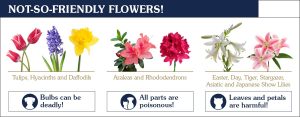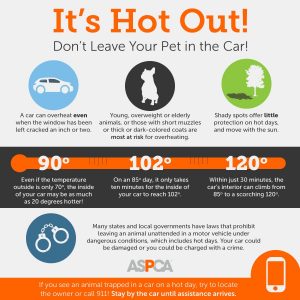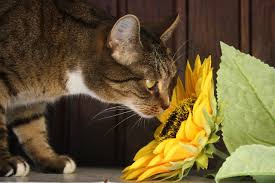Spring has officially sprung but before you embark on seasonal chores or outdoor festivities, take inventory of potential springtime hazards for your furry friends. Warmer weather, blooming plants and buzzing insects can all spell trouble for your pets. It’s important to know about the new hazards that springtime might bring your 4 legged friends, so that you can keep them safe and enjoy the season together.
Spring Cleaning
Not that your pets will help with spring cleaning, but they may try to lick at something you’ve just cleaned. So, keep them away from potentially toxic products such as undiluted bleach, oven and grill cleaners, toilet and drain cleaners, rust removers and calcium/lime removers.
Keep pets away from laundry pods, which can cause vomiting, coughing and other respiratory issues. Pets that like to chew on unused fabric softener sheets can experience ulcers in their mouths and throats, and when enough dryer sheets are consumed, they can lead to a gastrointestinal blockage.
As a reminder, this holds true all year round. It’s just much more common to have cleaners out in the open come springtime.
Plan Your Garden Wisely

If you have a dog who loves to dig in the garden, don’t let them near tulips, hyacinths or daffodils. Chewing on the bulbs, where the toxins are most concentrated, can result in vomiting, diarrhea and worse.
Azaleas and rhododendrons can be a problem for both cats and dogs. All parts of the plants are poisonous, and some pets only need to eat one or two leaves to experience signs of toxicity including vomiting, diarrhea, weakness and seizures. Although some lilies are safe for cats, others can cause acute kidney failure and death. Among the most dangerous are Easter, day, tiger, stargazer, Asiatic and Japanese show lilies. It only takes a few leaves, petals or a bit of pollen to cause a problem. Even drinking the water from the vase is dangerous. Signs of toxicity include drooling, vomiting, frequent urination and seizures.
Curb Other Gardening Hazards
Love the sweet scent of cocoa bean mulch? Your dog probably does, too. But this kind of mulch can contain the same potentially toxic substances found in chocolate. If your dog eats large quantities, it can lead to vomiting, diarrhea, seizures, gastrointestinal blockages and worse.
While you might assume that gardening with compost is natural and safe, decaying organic matter is the perfect environment for molds to flourish. When mycotoxins from the molds are eaten by pets or wildlife, they can produce signs such as panting, vomiting, tremors and seizures. So, fence off any compost to prevent animal access.
The word organic does not mean pet safe. As you can imagine, bone and blood meal are particularly attractive to dogs. But when large amounts are eaten, a solid clump can form in the stomach or intestines, acting as a roadblock and possibly requiring emergency surgery. Fertilizers, pesticides and insecticides containing organophosphates can produce life-threatening effects, even in small amounts, so it’s best to read the label and avoid them when possible. Keep pets away from areas recently treated as the chemicals can be absorbed through paws or ingested when grooming. And be sure to place all products out of reach when not in use.
Protect Your Pet from Parasites
As soon as the mercury begins to rise, fleas, ticks and mosquitos — the carriers of heartworms — become active, too. Once fleas get to your pet, they can overrun your house, transmit tapeworms (to pets and family members), and cause severe itching. Ticks and mosquitos can also transmit disease-causing agents. If your pet hunts prey or frequents the dog park, they can be at risk for intestinal worms transmitted from other animals. It’s best to see your veterinarian for an effective and safe parasite preventive.

Temperatures are Rising
The sun is shining and pets want to be outside, especially if you are. Keep them well-hydrated and provide shade when outdoors. An air-conditioned house is safest, but the next best thing is a well ventilated and insulated doghouse, a catio or a shaded porch with a fan or misting system.
Fresh drinking water must be supplied all day long making sure that outside bowl remains in the shade even when the sun moves in the late afternoon. For outdoor cats, try a saucer, glass or coffee mug which won’t brush whiskers to make the experience more enjoyable. If feeding outdoors, food bowls should be placed in a pan containing a few inches of water to keep ants out.
When transporting pets, never leave them unattended in a vehicle, even for a few minutes! Temperatures can skyrocket quickly, resulting in life-threatening conditions.
Prepare for Thunderstorms
Many dogs experience extreme anxiety at loud noises, such as thunder and fireworks. At the first hint of a storm, they may pace and whimper, hide or become immobilized. If left alone in the house during a storm, stressed dogs may attempt to escape, scratching and chewing near doors or even leaping through windows.
If that sounds familiar, prepare for storm season with a visit to your veterinarian. They can recommend behavior techniques that may help your dog become less sensitive to noises. Providing your dog with a “safe room” that’s away from windows and filled with their favorite bed and toys may offer a quiet respite. There are also pressure shirts and medications that can help your dog ride out the storm.
Keep Poison Control On Hand
Remember, if you’re worried that your pet may have been exposed to something toxic, contact your veterinarian or call the ASPCA Animal Poison Control Center at (888) 426-4435 immediately.






Leave a Reply